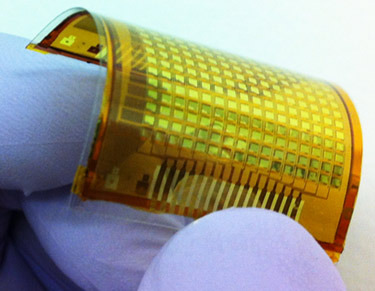Paper-thin e-skin responds to touch
Friday, 26 July, 2013
UC Berkeley researchers have created new electronic skin, or e-skin, that responds to touch by instantly lighting up. The more intense the pressure, the brighter the light it emits.
Ali Javey, associate professor of electrical engineering and computer sciences at US Berkeley, and his team of researchers have created the first user-interactive sensor network on flexible plastic.
“We are not just making devices; we are building systems,” said Ali Javey, associate professor of electrical engineering and computer sciences. “With the interactive e-skin, we have demonstrated an elegant system on plastic that can be wrapped around different objects to enable a new form of human-machine interfacing.”
This latest e-skin, described in a paper published online in the journal Nature Materials, builds on Javey’s earlier work using semiconductor nanowire transistors layered on top of thin rubber sheets. In addition to giving robots a finer sense of touch, the engineers believe the new e-skin technology could also be used to create things like wallpapers that double as touch-screen displays and dashboard laminates that allow drivers to adjust electronic controls with the wave of a hand.

“I could also imagine an e-skin bandage applied to an arm as a health monitor that continuously checks blood pressure and pulse rates,” said study co-lead author Chuan Wang, who conducted the work as a post-doctoral researcher in Javey’s UC Berkeley lab.
The experimental samples of the latest e-skin measure 16-by-16 pixels. Within each pixel sits a transistor, an organic LED and a pressure sensor. “Integrating sensors into a network is not new, but converting the data obtained into something interactive is the breakthrough,” said Wang, who is now an assistant professor of electrical and computer engineering at Michigan State University. “And unlike the stiff touch screens on iPhones, computer monitors and ATMs, the e-skin is flexible and can be easily laminated on any surface.”
To create the pliable e-skin, the engineers cured a thin layer of polymer on top of a silicon wafer. Once the plastic hardened, they could run the material through fabrication tools already in use in the semiconductor industry to layer on the electronic components. After the electronics were stacked, they simply peeled off the plastic from the silicon base, leaving a freestanding film with a sensor network embedded in it.
“The electronic components are all vertically integrated, which is a fairly sophisticated system to put onto a relatively cheap piece of plastic,” said Javey. “What makes this technology potentially easy to commercialise is that the process meshes well with existing semiconductor machinery.”
Javey’s lab is now in the process of engineering the e-skin sensors to respond to temperature and light as well as pressure. UC Berkeley co-authors on this study are David Hwang, Zhibin Yu and Kuniharu Takei, all of whom have joint appointments at the Berkeley Lab. Additional study co-authors are Junwoo Park, Teresa Chen and Biwu Ma from LBNL. The Defense Advanced Research Projects Agency and the Department of Energy helped support this research.
'Pain-on-a-chip' device identifies chronic pain types
Scientists have revealed a microfluidic device nicknamed 'pain-on-a-chip' that can...
Novel biosensor increases element extraction efficiency
Biologists have developed a novel biosensor that can detect rare earth elements and could be...
Making sensors more sustainable with a greener power source
A new project aims to eliminate the reliance of sensors on disposable batteries by testing the...





